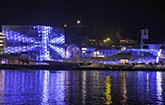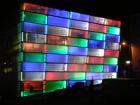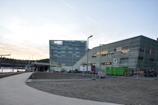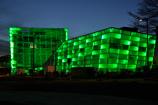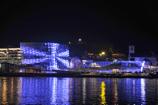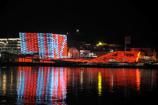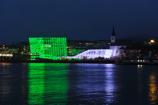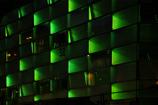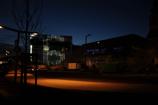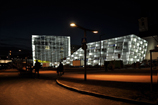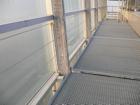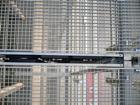








- Raiffeisen Tower
- Funicular
- Metro Station
- Tower 185
- Welios
- Boysen
- AEC
- Sillpark
- Delfin
- Power Tower
- Q19
- maxcenter
5,000 m² building shell as media facade
The Ars Electronica Center (AEC) in Linz has been wrapped with one of Europe's largest light facades since January 1, 2009. 40,000 LEDs illuminate the partially transparent and partially translucent glass surfaces from a space behind the facade. The specially developed LED lighting strips are mounted vertically on one side of the 1,100 glass panels and are therefore not visible.
Endless display variations
The brightness and color mixture of each panel light is individually controllable. The quick reaction of each individual light diode optimally transforms into a dance of flowing movements and color gradients.
LED lighting strips for special requirements
Multivision developed and produced its own lighting ballast in reconciliation of the requirements of architects DI Andreas Treusch and GIG FASSADEN. They are unique in that all components are integrated into the facade construction in a way that makes them invisible to the observer. Even the installed 20,000 meter cable is invisible.
The lighting strips are between 12 and 23 cm long and equipped with anywhere from 4 to 48 high power LEDs. A special optic that homogeneously distributes light onto the glass panel is attached to each light diode.
3 to 5 kilowatts of power at night
At twilight the LEDs display the facade with 100% luminosity, whereas the light spectacle only requires 20-30% power after dark. The normal night-time power requirement averages three to five kilowatts.
Gerfried Stocker, Artistic Director at Ars Electronica Center:
"The media facade represents for us a platform of communication that is unique because of its size and the possibilities it presents. We invite artists from all over the world to create displays."
Architect DI Andreas Treusch:
"Next to its extraordinary form, the lighting is one of the AEC's most impressive design elements. The LED facade uses shifting images to transport the artistic and dynamic presence of the building's interior and its uses."
Technical details
- 5.000 m² illuminated building shell
- 40.000 LEDs
- 4.400 channels, each individually controllable and adjustable
- 3-5 kW during normal night operation (20-30 % power)

 Deutsch
Deutsch